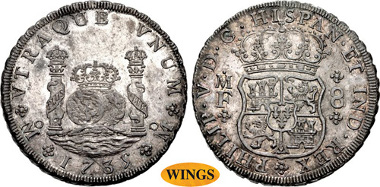
PREV ARTICLE
NEXT ARTICLE
FULL ISSUE
PREV FULL ISSUE
COINS OF SOUTH AMERICA FROM THE LISSNER COLLECTION
Last week CoinWeek had an article by D. Scott VanHorn on the history of South America told by coins from the Lissner Collection, being sold soon by Classical Numismatic Group (CNG) and St. James's Auctions. Here's an excerpt.
-Editor
The political and numismatic history of Central and South America begins almost immediately after the discovery of San Salvador by Cristóbal Colón (Christopher Columbus) on 12 October 1492. Under the terms of the 1494 Treaty of Tordesillas, which divided the newly-discovered lands outside of Europe between Spain and Portugal along an imaginary north-south line 370 leagues (1184 nautical miles) west of the Cape Verde Islands, Spain was to receive sole control over the New World. Because the terms failed to take into account the location of the continent of South America in relation to the boundary line, the tip of what is modern-day Brazil came under Portuguese control. For this reason, while the rest of Central and South America became part of the Spanish Empire and followed the currency system of Spain, Brazil’s coinage is based on that of Portugal. To control all Spanish exploration and colonization, and to collect import duties and taxes of all goods entering Spain, the Casa y Audiencia de Indias, more commonly known as the Casa de Contratación, was established in Seville. The Spanish colonization of the Americas, sometimes referred to by the Spanish Conquista, involved numerous adventurers, known as conquistadores, and religious missionaries (the Dominicans, Franciscans, and Jesuits), groups that emphasized the primary overseas aims of the Spanish government – conquest of new territory for raw materials, particularly gold and silver, and religious conversion of the local native populations to Christianity (i.e. Roman Catholicism). ... The New World territories used the Spanish monetary system of the coinage first instituted by Fernando and Isabella in Medina del Campo in 1497, consisting of silver reales (and its multiples and fractions).

MEXICO, Primera República. 1823-1863. AV 4 Escudos. In 1535, the gold escudo replaced the gold excelente and thenceforth, this became the basis for all the colonial coinage of Spanish America. The discovery of local sources of both gold and silver, particularly the Cerro Rico in Potosí, Bolivia (which provided Spain 41,000 metric tons of silver between 1556 and 1783), necessitated the creation of a number of new mints, not only for local consumption, but also for the export of the quinto real, or crown’s portion, sent back to the Casa de Contratación on the large plate fleets. The Mexico City mint (established in 1535) was one of the most important of these mints; the other, Potosí (established in 1574), was located at the source of the ore. Later, other mints were established and operated from time to time to handle the discovery and export of the metal. Until the eighteenth century, hammered coinage was struck. Known as macuquinas, or cobs, these coins became associated with later images of pieces of eight (due to eight reales being cut into pieces for fractions), and pirates on the Spanish Main.

1872: MEXICO, Colonial. Felipe V. King of Spain, second reign, 1724-1746. AR 8 Reales. To read the complete article, see: The history of South America told by coins from the Lissner Collection (www.coinsweekly.com/en/The-history-of-South-America-told-by-coins-from-the-Lissner-Collection/8?&id=413&type=a)

Wayne Homren, Editor The Numismatic Bibliomania Society is a non-profit organization promoting numismatic literature. See our web site at coinbooks.org. To submit items for publication in The E-Sylum, write to the Editor at this address: whomren@gmail.com To subscribe go to: https://my.binhost.com/lists/listinfo/esylum All Rights Reserved. NBS Home Page Contact the NBS webmaster 
|